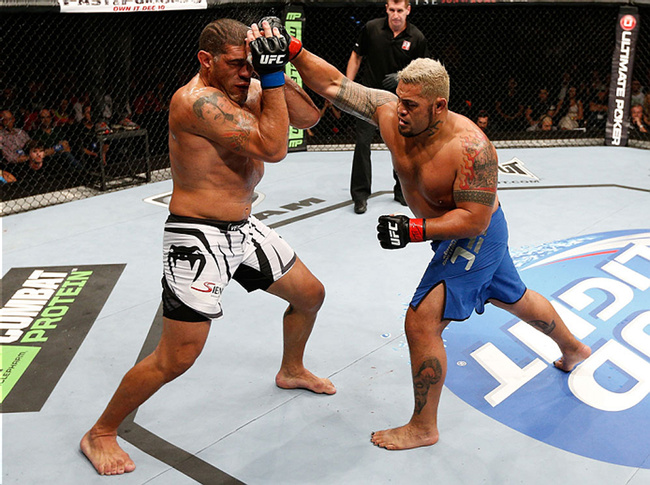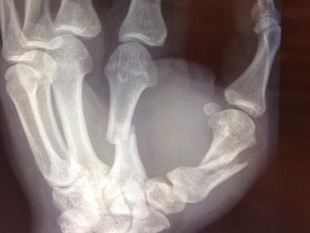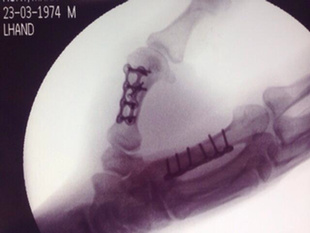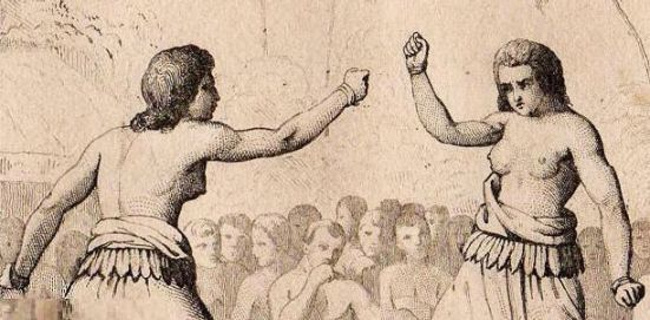In December of 2013, New Zealand born Samoan and mixed martial arts fighter Mark Hunt broke his hand on the head of Antonio Silva. It was during the main event of a UFC Fight Night, held in Brisbane, Australia. The two Heavyweight's five round war was reportedly one of the most torrid in the history of the UFC, and after the fight Mark revealed he had fractured his hand in two places. Although the fight ended in a majority draw, there was no argument about the determination and courage of both fighters. It was a particularly proud night for Samoan and Pacific Islander fans of the UFC. As mixed martial arts has become popular worldwide, Mark and a growing number of athletes of Pacific Island descent have particularly excelled in these disciplines. As a fan of MMA, and as a Pacific cultures researcher, I was no different, and enjoyed watching Mark as I always had. But, the fact that Mark is Samoan and that he had happened to have broken his hand in such dramatic circumstances, I was reminded of my knowledge of the venerable indigenous fighters and the greater history of broken hands in the Pacific.
It was a particularly proud night for Samoan and Pacific Islander fans of the UFC. As mixed martial arts has become popular worldwide, Mark and a growing number of athletes of Pacific Island descent have particularly excelled in these disciplines. As a fan of MMA, and as a Pacific cultures researcher, I was no different, and enjoyed watching Mark as I always had. But, the fact that Mark is Samoan and that he had happened to have broken his hand in such dramatic circumstances, I was reminded of my knowledge of the venerable indigenous fighters and the greater history of broken hands in the Pacific.
 In November, almost a month before the fight, I attended a talk by archaeologist Dr. Janet Davidson at The Museum of New Zealand Te Papa Tongarewa. It was titled Studying the people of the past: changing attitudes and new developments. In the talk, Janet discussed the study of human remains in archaeological sites and what they can tell us about the ancient Pacific past. She mentioned her archaeological fieldwork in the islands of Tonga in 1964, when she was given permission by then Tongan Prime minister, Prince Tui Pelehake, to analyze two large ancient burial mounds full of the remains of people.Several different scientific experts have studied the remains in detail over the last 50 years. Their studies have shed light on historical aspects of diet, genetics and disease, such as gout, that can be of tremendous importance to present day descendants. However, as Janet pointed out there is always more to learn. She highlighted the work of Dr Hallie Buckley, who leads research in biological anthropology at the University of Otago, and wrote a thesis on the health of the Tongan people uncovered in the burials. During her analysis of the remains, Buckley was puzzled when she discovered that the finger bones of many of the people burried were broken. This was very peculiar, as no archaeologists had previously noticed or remarked on this particular aspect of the Tongan remains. She asked Janet if ancient Tongans went in for hand-to-hand fighting. Janet could confirm that they did.
In November, almost a month before the fight, I attended a talk by archaeologist Dr. Janet Davidson at The Museum of New Zealand Te Papa Tongarewa. It was titled Studying the people of the past: changing attitudes and new developments. In the talk, Janet discussed the study of human remains in archaeological sites and what they can tell us about the ancient Pacific past. She mentioned her archaeological fieldwork in the islands of Tonga in 1964, when she was given permission by then Tongan Prime minister, Prince Tui Pelehake, to analyze two large ancient burial mounds full of the remains of people.Several different scientific experts have studied the remains in detail over the last 50 years. Their studies have shed light on historical aspects of diet, genetics and disease, such as gout, that can be of tremendous importance to present day descendants. However, as Janet pointed out there is always more to learn. She highlighted the work of Dr Hallie Buckley, who leads research in biological anthropology at the University of Otago, and wrote a thesis on the health of the Tongan people uncovered in the burials. During her analysis of the remains, Buckley was puzzled when she discovered that the finger bones of many of the people burried were broken. This was very peculiar, as no archaeologists had previously noticed or remarked on this particular aspect of the Tongan remains. She asked Janet if ancient Tongans went in for hand-to-hand fighting. Janet could confirm that they did. Historically, boxing and wrestling were demonstration sports in Tonga, and were witnessed by members of (English explorer/Imperialist) James Cook's third expedition to the Pacific (1776–80). An artist on the voyage depicted fighting on the island of Ha'apai featuring two pairs of men in combat: one pair with wooden weapons and one with their fists wrapped with a length of cordage (an ancient predecessor to MMA handwraps perhaps). Accounts of the boxing during the voyage note that up to 3000 spectators could be present. One of the fighters' favorite and most dexterous blows was to "turn round on their heel just as they have struck their antagonist and give him another very smart one with the other hand backwards." Women boxed with as much dexterity as the men. Boys and even little girls would "box very bitterly" for short periods of time. All boxers who lost a bout appeared to sit down with indifference as if they had never fought at all. A few of Cook's sailors who took on the Tongans (in both disciplines) were in the words of one observer "worsted."After leaving, James Cook wrote, "unoccupied Tongans entertained themselves with boxing and wrestling, women sometimes as well as men, and boys and girls… The Tongans staged boxing and wrestling matches, inviting sailors into the ring and promptly defeated them except when they let the sailors win for diplomatic reasons."
Historically, boxing and wrestling were demonstration sports in Tonga, and were witnessed by members of (English explorer/Imperialist) James Cook's third expedition to the Pacific (1776–80). An artist on the voyage depicted fighting on the island of Ha'apai featuring two pairs of men in combat: one pair with wooden weapons and one with their fists wrapped with a length of cordage (an ancient predecessor to MMA handwraps perhaps). Accounts of the boxing during the voyage note that up to 3000 spectators could be present. One of the fighters' favorite and most dexterous blows was to "turn round on their heel just as they have struck their antagonist and give him another very smart one with the other hand backwards." Women boxed with as much dexterity as the men. Boys and even little girls would "box very bitterly" for short periods of time. All boxers who lost a bout appeared to sit down with indifference as if they had never fought at all. A few of Cook's sailors who took on the Tongans (in both disciplines) were in the words of one observer "worsted."After leaving, James Cook wrote, "unoccupied Tongans entertained themselves with boxing and wrestling, women sometimes as well as men, and boys and girls… The Tongans staged boxing and wrestling matches, inviting sailors into the ring and promptly defeated them except when they let the sailors win for diplomatic reasons." As a Samoan, I have to say that in the 1800s, my ancestors also held boxing and wrestling on important occasions. However, archaeological research hasn't given us any evidence of too many broken hands to match exploits of our Tongan cousins. Mark Hunt has got the count started in a most memorable fashion. Much respect.
As a Samoan, I have to say that in the 1800s, my ancestors also held boxing and wrestling on important occasions. However, archaeological research hasn't given us any evidence of too many broken hands to match exploits of our Tongan cousins. Mark Hunt has got the count started in a most memorable fashion. Much respect.
Advertisement



Advertisement


